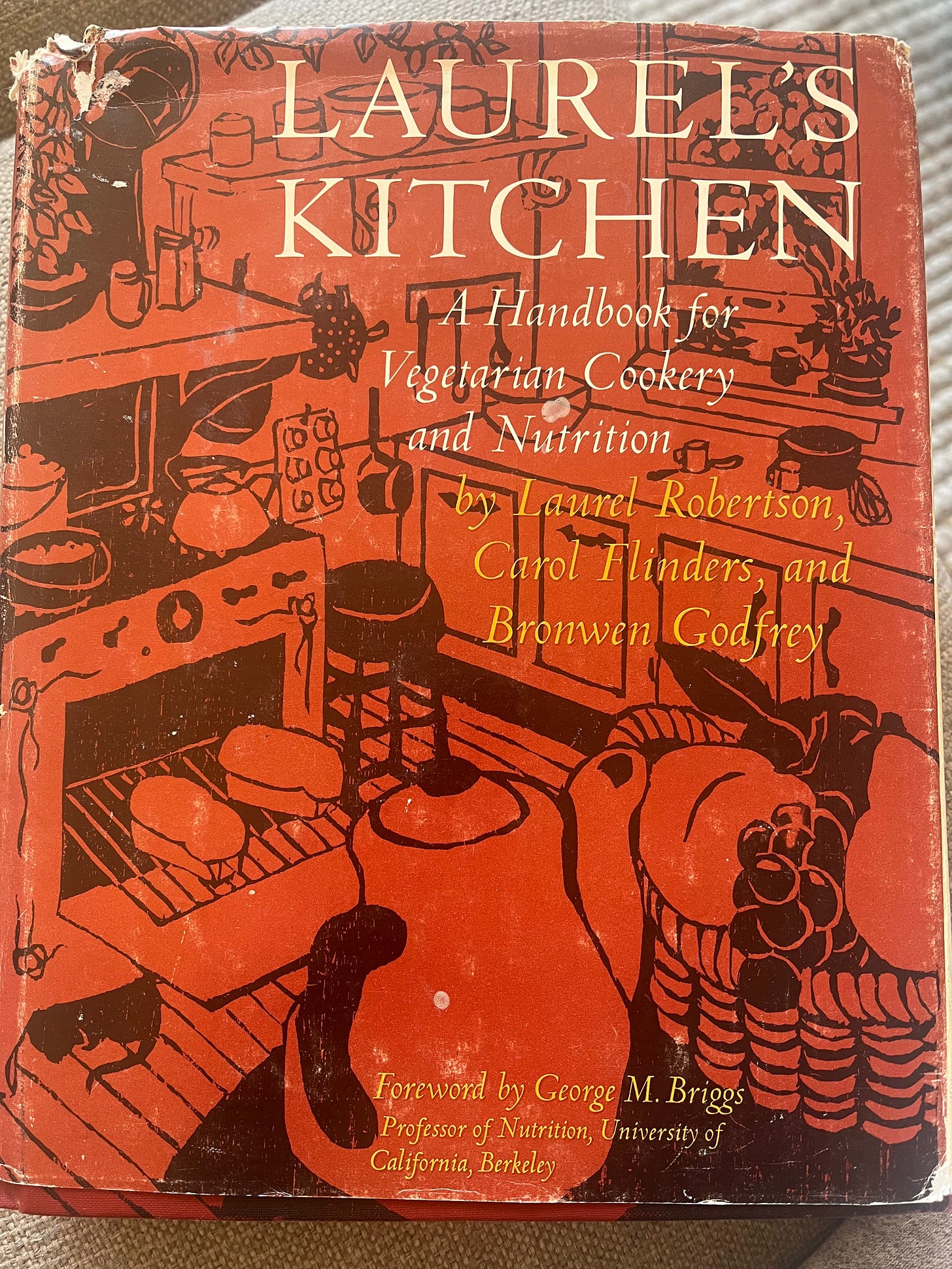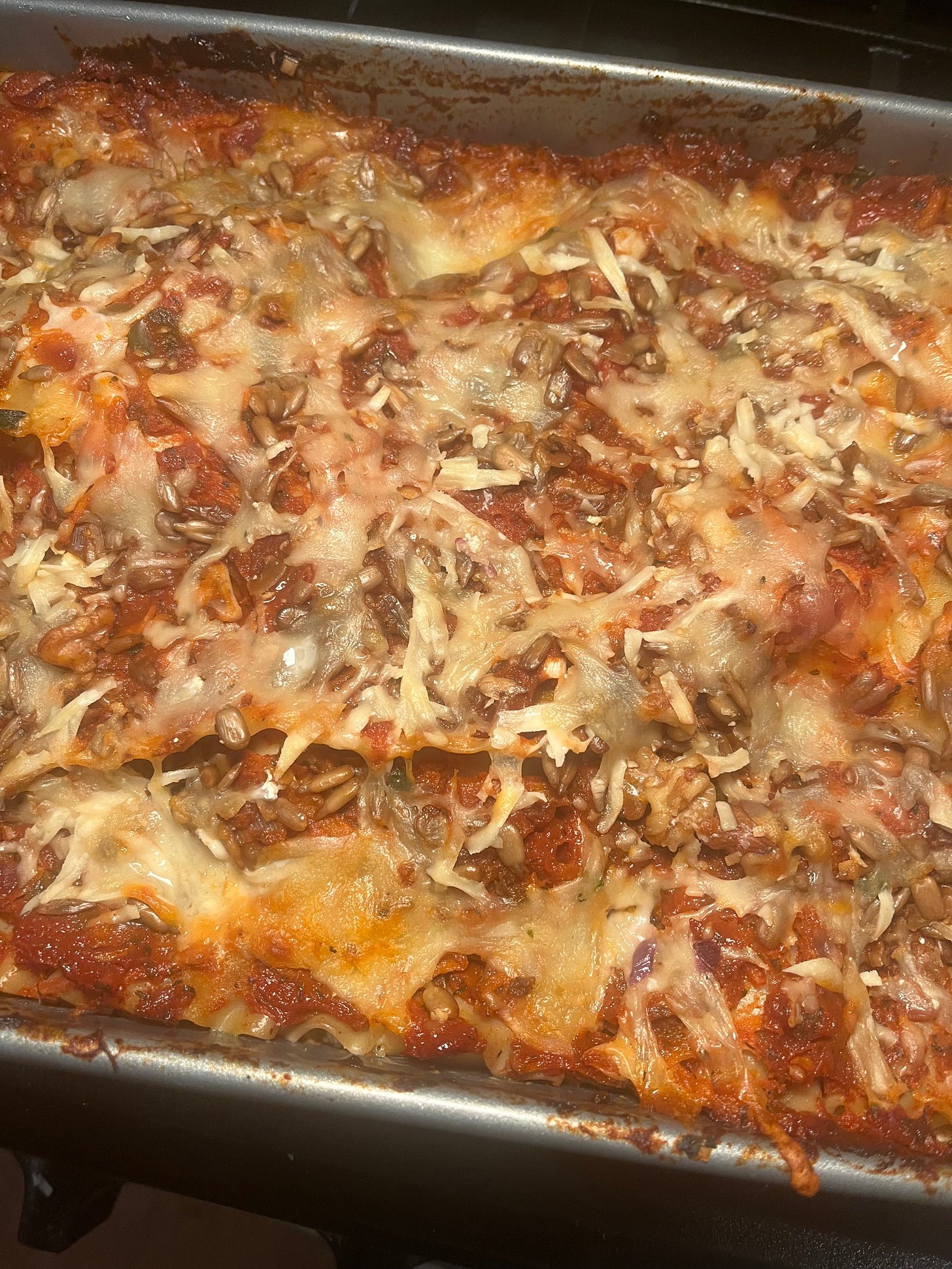But a vegetarian by commitment, however determined, is still a far cry from a competent vegetarian cook. I found myself the next morning, feeling distinctly miscast, in the Organic Foods Co-op. Tubs of beans, all colors and shapes, surrounded me, and barrels of noodles—buckwheat, whole wheat, soy, and spinach. Everything was beautiful: earthen-colored and completely free of cellophane wrappers, alluringly tactile. But no packaging meant no cooking instructions—and no visible means of getting the stuff out of the store. My stomach sank. Moving about me confidently on every side were lithe, tawny young men and women in faded blue denims, peasant blouses, and skirts made from old bedspreads, their thick manes braided, rubber-banded, or falling free. I was painfully conscious of my wash-and-wear shirtwaist dress.
Suddenly there was a familiar voice at my elbow. It was Laurel, her blue eyes like deep wells of concern. She looked no more Aquarian Age than I did, but that obviously didn’t faze her—she was completely at home.
“Can I help you find something?”
“Yes, I think I’m in over my head. What are the ground rules here?”
“You’ve never been here before? Gee, next to the Cheese Board it’s my favorite place. Did you see these?” Her eyes shining, she stuck her hand into a barrel of dark brown coffee beans and let them fall in a rich, fragrant cascade.
“Aesthetically, it’s the living end,” I agreed stiffly. “I should have brought my watercolors—but I was sort of hoping to take a few things home with me.”
Laurel kindly ignored my churlish manner and helped me find paper bags—they hid them, apparently, to encourage you to recycle your own—and a couple of scoops.
“Now,” she beamed, “what do you want?”
“I haven’t the vaguest idea. What do you think I want?”
She put down her scoop and looked at me with new respect.
“You really do need help, don’t you?”
I nodded sadly, mutely. Immediately, without a single wasted word, Laurel took the situation briskly in hand. Talking away about soaking times and cooking times, spices and sauces, she bagged several kinds of beans, then weighed out a few wide, flat, two-foot-long lasagna noodles made from whole wheat and soy flour. “These are fantastic. I’ll give you a recipe for them. But watch out they don’t crumble. They’re as brittle as two-foot potato chips.” — Carol Flinders
Surprisingly, this isn’t the opening to a 1970s Berkeley-set erotic lesbian short story. As far as I know, Carol never left her husband for blue-eyed Laurel, she just wrote a cookbook with her. Laurel’s Kitchen: A Handbook for Vegetarian Cooking and Nutrition, published in 1976, splits the difference between Anna Thomas’s sensual Vegetarian Epicure and Frances Moore Lappé’s science-minded Diet For A Small Planet. Flinders is a talented writer, her prose capturing the moment when the vegetarian hippie community grew up, worrying as much about food being less “devastating to the figure” as they were about their political, economic, and animal liberation ideologies. Reading the above passage makes me sad I missed the heyday of the Berkeley Co-op, which set up shop on University Blvd in 1937 and finally closed in 1988, as most socialist-minded co-ops do, due to “internal governance disputes and bankruptcy,” according to its Wikipedia page.
A contemporaneous New York Times profile claims the co-op wasn’t keeping up with the yuppified times:
In the 1980's, while Berkeley became one of the most influential and obsessed centers of new American cuisine, many people felt the co-op acted as though everyone still lived in a commune and bought brown rice in 50-pound sacks. The co-ops continued to stock six kinds of sprouts and a nasty looking substance called ''tofu puffs,'' but not raddichio [sic].
At its heyday in the 70s, the co-op operated 12 stores all around the Bay Area. The original University Blvd branch is now a Target. Is it too much to ask, in 2025, for a co-op that sells nasty-looking tofu puffs and radicchio? I actually don’t need them to sell sprouts because I grow my own 💅. In this era of increasing food prices and politically motivated boycotts of Amazon and Target, there has to be a real appetite for an old-fashioned worker-owned grocery store.
The Park Slope Co-op in Brooklyn (where I was a faithful member before getting excommunicated for rupturing my appendix and having to be hospitalized for a month, thus missing my Tuesday 4-7 receiving and stocking shift) is barely hanging on after the retirement of founder Joe Holtz. The few co-ops left in California, Santa Monica, South LA, West Oakland, aren’t even real co-ops that force every customer to work shifts. I don’t see any signs of a revival.
Alright, back to Laurel’s Kitchen. Don’t those two-foot-long, potato chip-thin whole wheat-soy lasagna noodles sound amazing? I went to three stores trying to find anything like them, to make my version of Laurel’s Lasagna al Forno as historically accurate as possible. Not only could I not find any whole wheat-soy lasagna noodles, I couldn’t even find any whole-wheat lasagna noodles. Whole wheat spaghetti, penne, rigatoni, easy. But lasagna? The choices were either gluten-free (usually made of rice) or regular. I made a split-second decision at the Los Feliz Blvd. Vons (my third supermarket in an hour on Sunday morning) and grabbed the Barilla. I want you to know I deeply regret my decision. At least with the gluten-free, I might have gotten something thinner and more delicate, so the pasta wouldn’t overwhelm the paltry amount of filling.
I did make Laurel’s homemade tomato sauce, rich with two whole tablespoons of chopped green bell pepper, a bay leaf, and minuscule amounts of dried thyme, oregano, and basil. The end result, very 1970s in the derogatory sense of the term: boring and underseasoned. It’s giving Prego.
I dutifully toasted my nuts and seeds — I used a half walnut/half sunflower combo because they were already in my cupboard — and they added a disconcerting crunch to a pretty standard spinach lasagna recipe. Inappropriate sunflower seeds signify “hippie food co-op” more than any other ingredient, and so they are mandatory.
As for the spinach, do you know how little spinach “one medium bunch” is? It probably cooks down to three, four ounces at most. I substituted the fresh spinach for a 16oz package of frozen, and it still wasn’t enough. I also used more mozzarella than recommended (a pound of whole-milk, low moisture), grated rather than cut into slices.
And I went for the cottage cheese, as much a 2025 “it” ingredient as it was in 1976. We’ve collectively replaced “not nearly so devastating to the figure” with “hitting your macros,” but it’s all the same shit. The 4% Good Culture was sold out at Whole Foods, so I settled for Nancy’s Probiotic. I guess Australia isn’t the only country experiencing a TikTok-inspired national cottage cheese shortage. Baked between an ungodly amount of plain lasagna noodles, those poor probiotics died a painful death after about one minute at 350°.
Maybe it’s the lack of brittle wheat-soy noodles, maybe it’s changing tastes, maybe Laurel wasn’t as great a recipe developer as the obviously sexually infatuated Carol Flinders believed her to be. Whatever the reason, this lasagna just didn’t hit. Not enough veggies, not enough cheese, not enough sauce. 1976 at the Berkeley Co-op seems like halcyon days, a simpler time before probiotic cottage cheese, billionaire-owned supermarkets, the slow death of community spaces. On the other hand, living in late capitalist doomsday, I have unlimited access to radicchio.








There was a larger (and I believe the original) Berkeley Co-op where today’s family owned Andronico’s sits on Shattuck, however, that family sold to Safeway a few years ago! I don’t shop there anymore. Used to enjoy the Co-op around 1976+ and in fact this is where Dad and I picked up our first kitten out in front, ‘Tango’. And of course, you came along not that long after. 😊